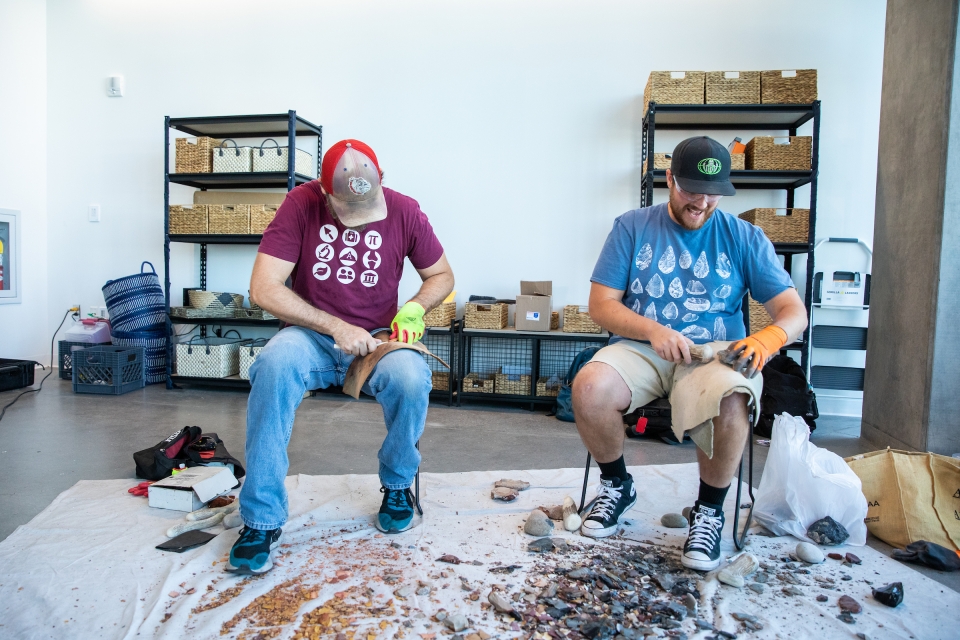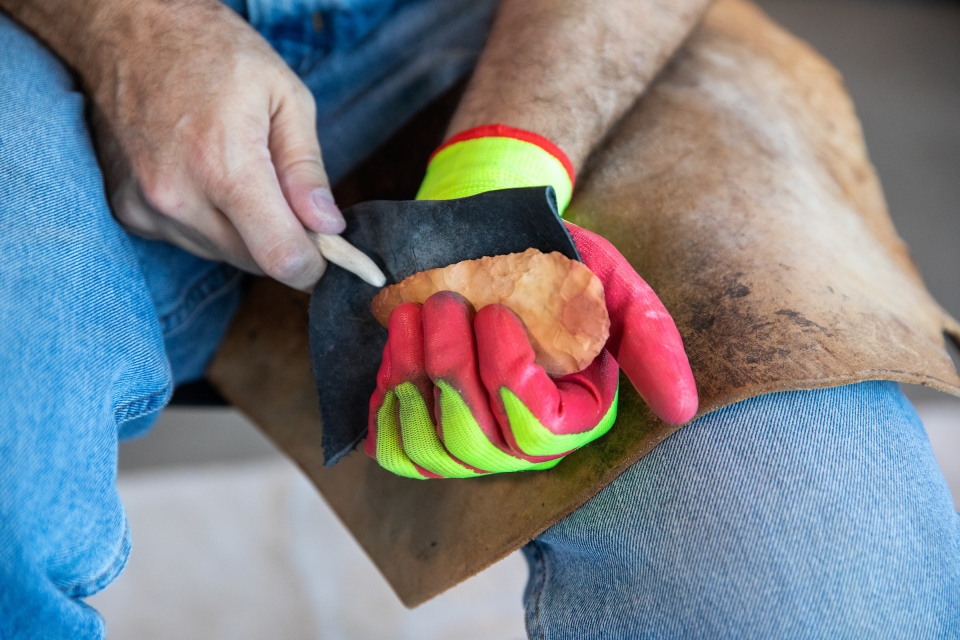Stone Age tool-making lab rocks for ASU students
If you walk by the glass windows of ASU’s Ancient Technology Lab at 10 a.m. on a Friday morning, chances are you will see two graduate students smashing rocks — sometimes with an antler hammer, other times with a large stone.
That would be John Murray and Nicolas Hansen.
The Arizona State University students are making stone tools, or what is more accurately called flintknapping. They work in the lab as part of their graduate studies and PhD research.
“It gives us a window into their world,” said Murray, a PhD student in the School of Human Evolution and Social Change, who studies Middle Stone Age tools and their heat treatment.
“We are sitting in someone else's shoes trying to solve a problem that people had for millions of years — making tools or simply trying to get a sharp edge.”
In short, the Stone Age tools have a story to tell.
"They are very informative because they help us understand how ancient Homo sapiens solved everyday problems in a variety of ways,” said Hansen, an ASU graduate student and Barrett College alumnus who researches human behavior from 35,000 to 250,000 years ago. “The variation of the tools are as informative as the tools themselves.”
“It tells us about their cognitive capacity and their social evolution,” said Murray, who teaches stone tool-making to undergraduate students. “You would need to know a language and how to communicate in order to teach others certain technologies.”
The Ancient Technology Lab is essential to their studies and those of other undergraduate, graduate and doctoral students on campus. There, students can engage in what is called “experimental” archeology — replicating ancient technology.
Their research is part of an effort to understand the evolution of human cognition as it relates to tool technology.
Experimental archaeology can provide answers to many questions about how humans made and used tools. Did they heat stones to make them easier to break? Did different groups share technology? Was the tool part of a bow and arrow or a spear that was thrown? Did they have a higher intelligence than scientists previously believed?
“It helps us take a bigger step back and say, ‘We are looking at millions of years ago, where they didn’t have iron or plastic.’ So stone was the main material they were using,” said Kathryn Ranhorn, assistant professor in the School of Human Evolution and Social Change and director of the lab. “We are trying to learn how these things were made. So when we find them in the archeological sites, we can better interpret the patterns we see.”

Doctoral student John Murray (right) and graduate student Nic Hansen (left) work on sharpening the edges of their stone tools in ASU's Ancient Technology Lab. Photo by Deanna Dent/Arizona State University
Tooling in the lab
Ranhorn started the lab in April 2022, in the new Rob and Melani Walton Center for Planetary Health, located on the corner of Rural Road and University Drive.
It is the only one of its kind at ASU.
Students walk into the lab space and take a step back in time to when tool technology such as hand axes, spears, arrowheads and more were used for everything from securing dinner to defending the family.
Ranhorn designed the concept and lab space. When the architect asked for her ideas, he got them.
Inspired by the educator-scholar model, she envisioned an educational space for both undergraduate and graduate students, including students on the PhD track, and she wanted it to be a dedicated research space where she could create opportunities for the public.
The space has two floor-to-ceiling glass walls where members of the community can observe flintknapping demonstrations in what Ranhorn describes as “a form of public archeology.”
“It is perfect. We are this kind of fishbowl,” she said.
“Most people don’t think about ancient technology everyday like I do,” Ranhorn continued. “But a lot of people wonder what is going on here. They can engage with our work at that level. That’s really cool.”
There was another important component she required for the lab.
“We needed a kind of space where we can make things and break things and get a little messy,” she said.
That is exactly what happens at 10 a.m. every Friday morning in the lab.
Surrounded by a graveyard of tiny chips off the stones, the students engage in the messiness of flintknapping — breaking jagged portions and flakes off of rocks to shape into tools.

Graduate student Nic Hansen works on sharpening the edges of his stone tool in the Ancient Technology Lab. Photo by Deanna Dent/Arizona State University
Is it solid rock?
But first, you have to find the right rocks for flintknapping.
It is not just a matter of picking up a garden variety rock on the hill. It takes the right rock to meet the criteria necessary to turn it into a stone tool.
Pale yellow chert, Perkinsville jasper and obsidian can be found in northern Arizona and are the types of stones Indigenous populations would have used.
With permission from the Bureau of Land Management and tribal authorities, Hansen and Murray will sometimes make the drive to search for this raw material.
The lab also creates their own raw materials for knapping with porcelain. With a sustainable supply of material, the experiments can be scaled up as needed.
With methods from engineering, the rocks are tested to determine if they have a high enough quality for tool-making.
Hot rocks
In Ranhorn’s Archaeological Science Lab on the second floor, some stones are moved to an electric kiln and are heat-treated up to 650 degrees for eight hours. The controlled environment provides insight into how the heat treatment impacts the rocks.
“The heat treatment technology would have been one of the first steps before refining it into a tool,” Murray said. “Knowing how to apply heat to stone and understanding these have higher quality — these are traits that reflect planning, skill and most likely teaching and learning.”
After the rocks are heated, they undergo further flintknapping tests. The entire process may take up to 24 hours.
Many of the tools become a part of the collection at the Institute of Human Origins, where nearly hundreds of rocks are on display. Or they may become a part of the outdoor decor for a researcher.
After eight years of studying and making stone tools, Murray says he has accumulated a lot of them.
“I think I have about 500 tools. I’m not completely sure. I have lost count of them.”
ASU students can learn more about stone artifacts in Ranhorn's courses Human Cultural Beginnings (ASB 361), Research in Stone Artifact Technology (ASM 573) and via the School of Human Evolution and Social Change's Research Apprenticeship Program.
Top photo: A view of stone tools and the stone tool-making process in the Ancient Technology Lab in the ISTB 7 building. Photo by Deanna Dent/Arizona State University